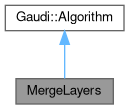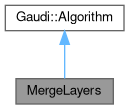|
| ServiceHandle< IGeoSvc > | m_geoSvc |
| | Pointer to the geometry service.
|
| |
| DataHandle< edm4hep::CalorimeterHitCollection > | m_inHits {"hits/caloInHits", Gaudi::DataHandle::Reader, this} |
| | Handle for the EDM Hits to be read.
|
| |
| DataHandle< edm4hep::CalorimeterHitCollection > | m_outHits {"hits/caloOutHits", Gaudi::DataHandle::Writer, this} |
| | Handle for the EDM Hits to be written.
|
| |
| dd4hep::IDDescriptor | m_descriptor |
| |
| Gaudi::Property< std::string > | m_readoutName {this, "readout", "", "Name of the detector readout"} |
| | Name of the detector readout.
|
| |
| Gaudi::Property< std::string > | m_idToMerge {this, "identifier", "", "Identifier to be merged"} |
| | Identifier to be merged.
|
| |
| Gaudi::Property< std::string > | m_volumeName {this, "volumeName", "", "Name (or its part) of the volume"} |
| | Name (or its part) of the volume.
|
| |
| Gaudi::Property< std::vector< uint > > | m_listToMerge |
| | List with number of adjacent cells to be merged.
|
| |
| Gaudi::Property< uint > | m_debugPrint {this, "debugPrint", 10, "Maximum number of lines in debug output"} |
| | Maximum number of lines in debug output.
|
| |
Merge layers (volume ids).
Merging is performed on a collection of hits and as a result only the cellID of hit is changed (in particular, the part of the volume ID). There is no real change of the geometry. GeoSvc is required (to access the detector readout). Common part of the name of the volumes to be merged is defined be property 'volumeName'. Name of the field in the readout that corresponds to the volume is defined be property 'identifier'. Property 'merge' describes how many adjacent volumes should be merged. E.g. 'merge = [2,3,2]' means that first 2 volumes are merged into new cell (id=0), next 3 volumes become new cell (id=1), and finally last 2 layers are merged into last cell (id=2). The sum of all sizes from the list should correspond to the total number of volumes named as indicated in 'volumeName'. For an example see Detector/DetComponents/tests/options/mergeLayers.py
- Author
- Anna Zaborowska


